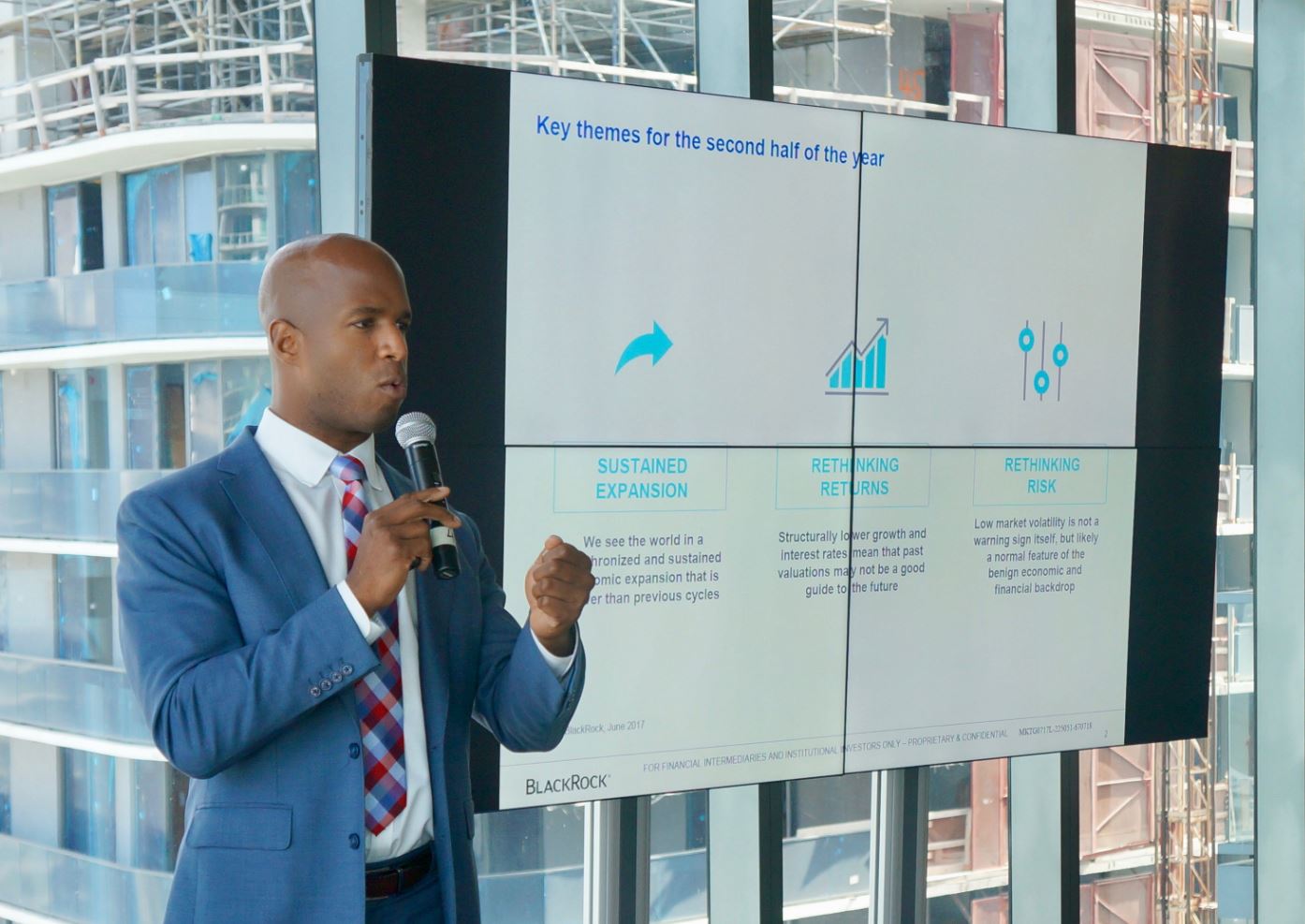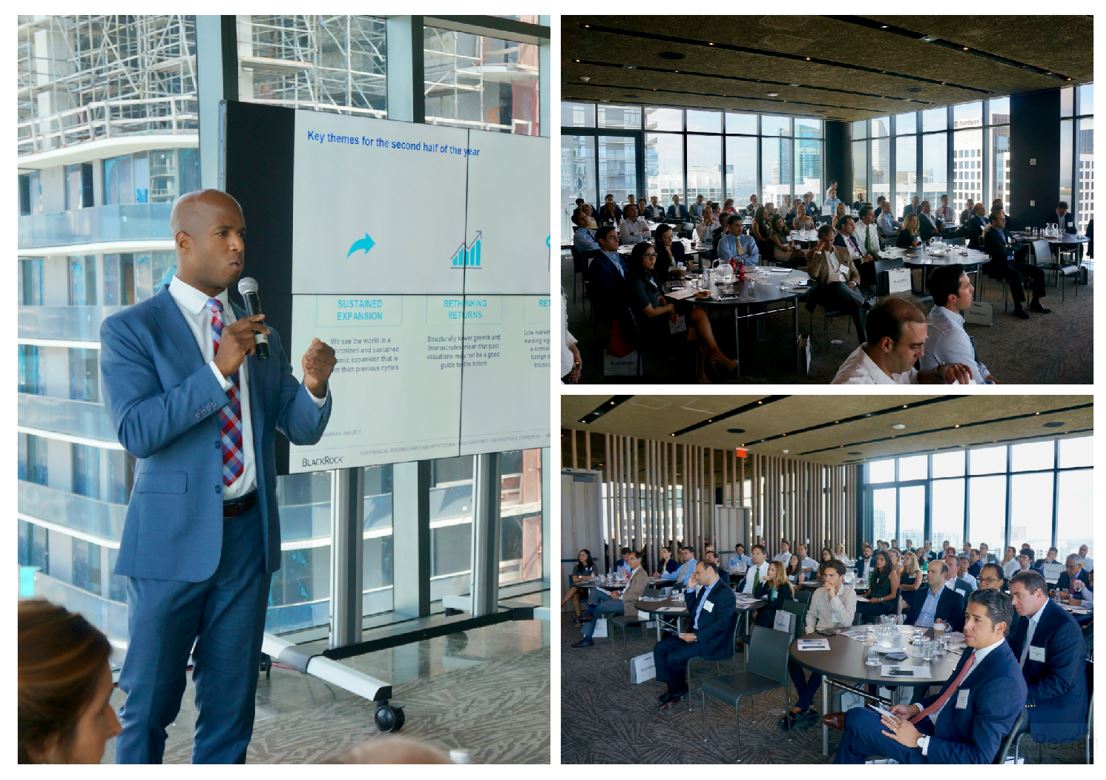In an environment where volatility levels are at a minimum, partly because of the widespread measures of QE by central banks and the low volatility of macroeconomic variables such as GDP, and the employment and inflation rates, the Black Rock Investment Institute is committed to maintaining current risk exposure, and even to increasing it. From here, the question that makes sense is: Given the present conditions, where do you take that risk within the capital markets? Terry Simpson, a multi-asset investment strategist, met in Miami in mid-July to resolve this issue and to share the firm’s expectations about the different markets.
Over the next five years, they expect US large-cap equities, as well as small- and medium-cap equities, to deliver an average return of 4 %. Also, for the same time horizon, they expect developed global equities, excluding US, to achieve an average yield of 6.2% and emerging market equities to reach 7%.
“These differences in returns are due to the high valuation levels in the US equity market, which are vulnerable to mean reversion. But we also believe there is an opportunity in the growth of global volatility within this economic cycle and we want to tilt our portfolios to where growth will emanate from. We know that the US economic cycle is much more mature than that of the Eurozone, emerging markets, or Japan, so these economies have scope for catch up,” said Terry Simpson.
“Thinking about valuations and rethinking asset allocations, we often get the question about the high valuations in financial markets, which is true whether you look across equities or you look across bonds. Bonds valuations are at historically high valuations. While equities also are at high historical valuations, they are not as expensive when compared to bonds. Thus, the key is relative value,” he added.
A Clear Commitment to Equities
The issue here is betting on relative value: If we invest in equities, how much premium are we offered in relation to investment in bonds? For the firm, these questions make more sense than to think about equities in absolute terms, as the vast majority of clients have positions in multi-asset portfolios. In addition, we are already eight and a half years into the cycle, so valuation levels are high: “If you compare the earnings yield of the S&P 500 index with the premium provided by equities- it can be calculated as the earnings yield of US Equities minus the real bond yield in the US markets- it can be seen that stock market valuations are high, but if the same yield is compared to bonds, one will see equities are still relatively cheap, and that is why we continue to maintain an overweight in equities in relation to bonds, even eight and a half years into the cycle.”
Another reason why the BlackRock Investment Institute favors equities is because earnings growth is now becoming a sustained part of this market: “We have long understood that this is a multiple expansion bull market, lacking an earnings growth recovery, yet we are at point of solid earnings growth. Q1 in 2017 was the first quarter since 2010, when all the major global regions recorded double digit positive EPS growth. So, it’s confusing that clients are taking money out of markets now that we are getting earnings growth. It is likely that growth in the first quarter of this year will not be recorded again because in some regions currencies have risen which may act as a headwind for earnings, but we still think that in Europe and Japan double digits earnings growth is feasible for Q2, while in the US we expect it to remain at the top end of single digits. In any case, this is a marked improvement from years past.”
Furthermore, one could consider Wall Street’s expectations, since there is a trend that began around 2010-2011. Since then, analysts broadcasted very high expectations in terms of earnings per share at the beginning of each year, yet as the year progressed, those expectations were adjusted downwards becoming more and more pessimistic. However, 2017 is the first year in which the expectations broadcasted at the beginning of the year remained practically flat, something that according to Terry Simpson should be interpreted as an encouraging fact, since it breaks with the previous pattern and in addition is being supported by an improvement in profit recovery.
Opportunities are Outside the US
At BlackRock, they began to think that there would be investment opportunities in the international markets at the tail end of last year, a position that at that time was identified as contrarian to market consensus. The rest of the market is now just getting on board, so their contrarian call is no longer contrarian. Will they adjust their position? Not quite yet.
“When we analyze the fundamentals of certain regions, our takeaway remains positive. For example, in Europe, the percentage of countries that have PMIs above their historical average is at its highest level since 2011”.
“Prior to 2009, EPS in European equity markets, excluding the UK, was virtually in line with that of the United States, as was earnings growth, obviously as a result of increased globalization. After the Great Financial Crisis, US earnings continued to increase somewhat, but in Europe they basically remained flat or declined. We think that the gap has potential to close as the global economy picks up. This is a fundamental story, there is an opportunity that Europe is going to catch up to the US”, he explained.
Regarding the need to protect and hedge the portfolio against currency risk, Simpson argued that it depends on risk tolerance and the client’s time horizon. “If you are looking for exposure to the European or Japanese equity market and the local currency is at a positive moment, you would be adding alpha to the portfolio with a direct exposure to currency risk, as is currently the case with the Euro and the Yen. Conversely, if the local currency is in a weak moment, as was the case during the past two years, it is convenient to opt for currency hedging strategies. With a high-risk tolerance and with a short time horizon, you can invest without currency hedging and take currency risk, but if the client does not want so much volatility in their portfolio, it is better to hedge the position. The same happens with the time horizon, over the course of 20-25 years, the effect of the local currency is washed out, there is basically no difference in terms of total return, but if you only want to invest for one or two years, it is better to hedge the risk”.
Finally, Simpson reviews the fundamentals that support investment in emerging markets. The differential between the growth of emerging and developed markets began to narrow in 2010. The growth of emerging markets started to converge with that of developed markets. It happened with China, which went from registering an annual growth of 10% to one of 6%, but this was also the case in Brazil and Russia. “In the last two quarters, we are seeing a rebound in the differential; emerging markets are restarting their growth. If this trend firms, we believe that EPS will grow and we will see better performance by emerging markets in relation to developed markets.”
From a technical perspective, Simpson recalled what happened in 2013, in the episode known as the “Taper Tantrum.” Ben Bernanke was Fed Chairman at a time when yields in developed economies were depressed; a massive flow of funds had invested in emerging market equities seeking higher yields. “At that moment Bernanke told global investors that they had reached the peak in the influence of QE measures, and that it may be optimal to withdraw the stimulus. A miscommunication that saw investors respond with a strong exit from emerging markets. Money has returned to this asset class, but there is still a lot of money waiting on the sidelines to reenter emerging markets, another positive point for this asset class,” he concluded.



